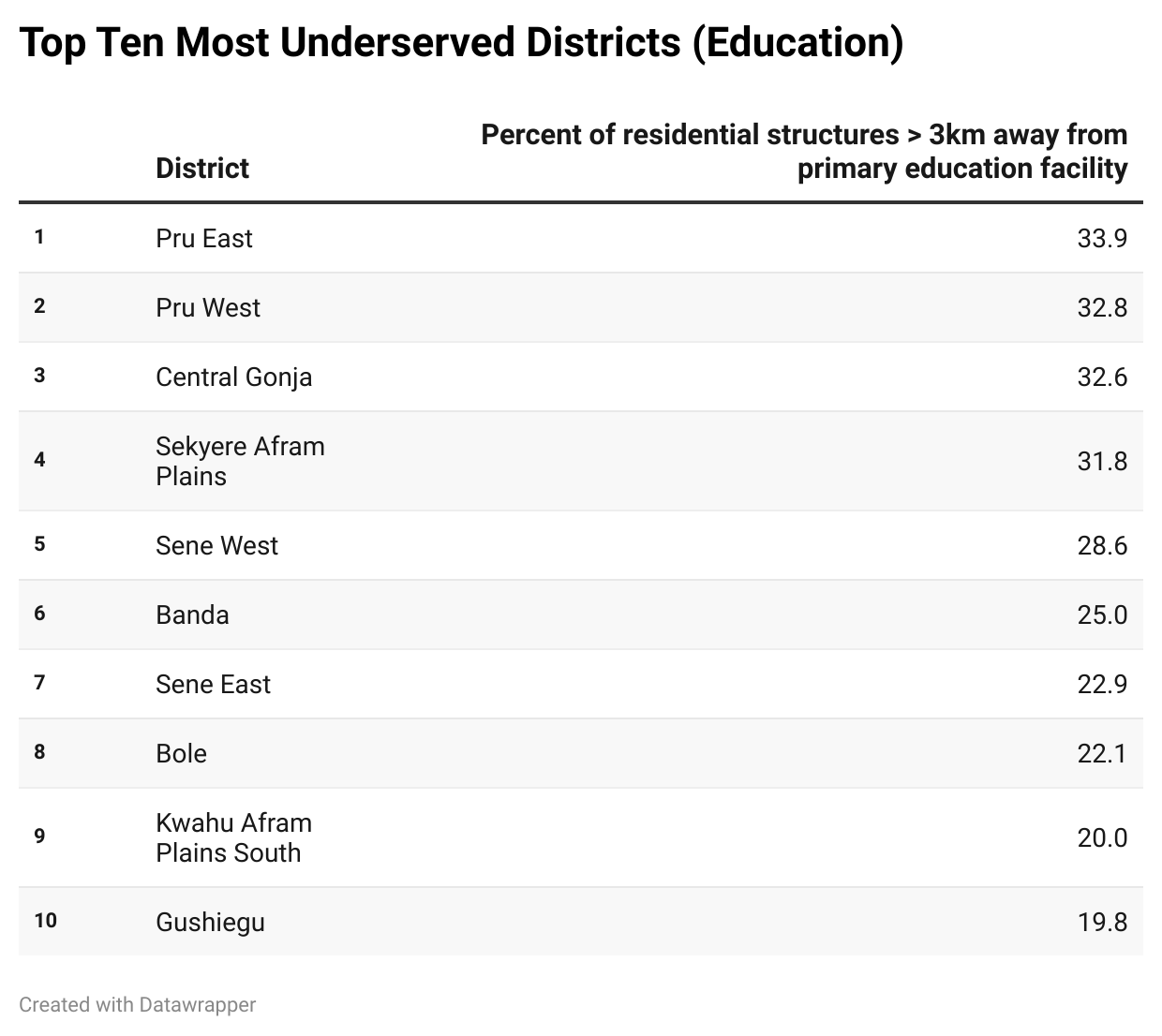Today, 19th October 2021, Ghana Statistical Service (GSS) presents preliminary findings from the 2021 PHC Residential Proximity to Essential Service Facilities Report.
Key Takeaways
- Seventy-three percent of residential clusters in rural areas nationwide do not have all the three required levels of basic education i.e. pre-primary, primary and junior high school.
- Nearly one-third of rural residential clusters nationwide (and 6% of urban clusters nationwide) do not have any facility providing education services.
- Seventy-three percent of rural residential clusters nationwide and 24% of urban areas nationwide do not have a facility providing health services.
- Over nine out of every ten (93%) of rural residential clusters nationwide and 38% of urban areas do not have a facility providing financial services.
- There are substantial disparities in the availability of essential services between urban and rural areas.
- Half of the residential structures (51%) in the country live outside the recommended distance (1km) radius from pre-primary school
- Over half (57%) of residential structures are located more than 5km from a bank compared with about two-thirds (66%) located more than 5km from a microfinance and over three-quarters (77%) located more than 5km from a savings/credit union.
- Savannah Region has the largest percent of residential structures living farthest from education and health services ranking last for all six facilities providing these essential services analysed.
- Greater Accra Region has the lowest percent of residential structures living farthest from education and health services ranking first for five out of the six facilities providing essential services analysed. The exception is residential proximity to health facilities where Greater Accra ranks second after Upper East.
- Stark inter-regional and intra-regional disparities exist in the proximity to essential services.
NB: Residential clusters are geographic units which are either localities with 1,000 or more inhabitants; or a group of contiguous localities with less than 1,000 inhabitants each combined.
Scope of the Report
The report uses georeferenced data generated from the 2021 Population and Housing Census (PHC) to generate statistics on the availability of facilities providing education, health and financial services, and the average distance between residences and these services. The data presented are disaggregated by type of place of residence (urban/rural), region and district. This report is designed to be a policy making tool to identify potentially underserved areas for targeted interventions.
NB: The statistics presented in this report are based on provisional population figures. The final results for the 2021 PHC will be released in November, 2021.
Rationale for the Report
The Universal Declaration of Human Rights considers education and health as basic human rights. Access to financial services, though not a human right, has been identified by the World Bank as a pathway to poverty reduction for individuals and risk mitigation and expansion of opportunities for small and medium scale enterprises.
Distance to access services is negatively correlated with population wellbeing. Proximity to schools is linked to higher attendance and retention, especially for girls. Distance to health facilities is negatively correlated with health outcomes including immunisation birth registration, delay in seeking care, and antenatal care coverage. Distance to financial institutions is one of the key factors for not owning a bank account, a barrier to accessing formal financial services.
The disaggregated statistics presented in the report will aid with the implementation and tracking of Sustainable Development Goal (SDG) 10 to reduce inequality within and among countries. Further, essential services included in this report align with Sustainable Goals 3 (ensure health and well-being for all, at every stage of life), 4 (ensure inclusive and equitable quality education and promote lifelong learning opportunities for all); and 8 (promote inclusive and sustainable economic growth, employment and decent work for all).
About the 2021 Population and Housing Census
The 2021 Population and Housing Census (PHC), Ghana’s first fully digital census, employed technology in all aspects of its implementation. It leveraged on technology available to improve operational efficiency, enhance the quality of the data collected and be able to release results in a timely manner. To learn more about the uniqueness of the 2021 PHC, download the basics of the census document and download the resources under the information centre.
Data Quality
The 2021 PHC instituted several data quality monitoring mechanisms and leveraged technology to implement interventions towards ensuring complete and accurate coverage. Learn more about the 2021 PHC data quality assurance process in the pre-release fact sheet.


Explore more highlights from the report here
